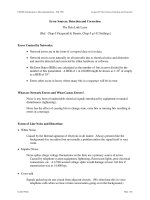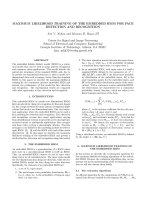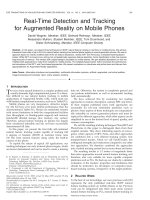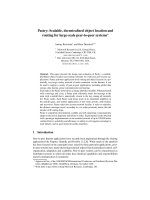2d object detection and recognition models, algorithms, and networks
Bạn đang xem bản rút gọn của tài liệu. Xem và tải ngay bản đầy đủ của tài liệu tại đây (7.21 MB, 325 trang )
2D Object Detection and Recognition
Models,Algorithms,and Networks
Yali Amit
amit-79020 book May 20, 2002 13:3
2D Object Detection and Recognition
i
This Page Intentionally Left Blank
amit-79020 book May 20, 2002 13:3
Yali Amit
2D Object Detection and Recognition
Models, Algorithms, and Networks
The MIT Press
Cambridge, Massachusetts
London, England
iii
amit-79020 book May 20, 2002 13:3
© 2002 Massachusetts Institute of Technology
All rights reserved. No part of this book may be reproduced in any form by any electronic or
mechanical means (including photocopying, recording, or information storage and retrieval)
without permission in writing from the publisher.
This book was set in Times Roman by Interactive Composition Corporation and was printed
and bound in the United States of America.
Library of Congress Cataloging-in-Publication Data
Amit, Yali.
2D object detection and recognition : models, algorithms, and networks / Yali Amit.
p. cm.
Includes bibliographical references.
ISBN 0-262-01194-8 (hc. : alk. paper)
1. Computer vision. I. Title.
TA1634 .A45 2002
006.3
7–dc21
2002016508
iv
amit-79020 book May 20, 2002 13:3
To Granite, Yotam, and Inbal
v
This Page Intentionally Left Blank
amit-79020 book May 20, 2002 13:3
Contents
Preface xi
Acknowledgments xv
1 Introduction 1
1.1 Low-Level Image Analysis and Bottom-up Segmentation 1
1.2 Object Detection with Deformable-Template Models 3
1.3 Detection of Rigid Objects 5
1.4 Object Recognition 8
1.5 Scene Analysis: Merging Detection and Recognition 10
1.6 Neural Network Architectures 12
2 Detection and Recognition: Overview of Models 13
2.1 A Bayesian Approach to Detection 13
2.2 Overview of Object-Detection Models 18
2.3 Object Recognition 25
2.4 Scene Analysis: Combining Detection and Recognition 27
2.5 Network Implementations 28
3 1D Models: Deformable Contours 31
3.1 Inside-Outside Model 31
3.2 An Edge-Based Data Model 40
3.3 Computation 41
vii
amit-79020 book May 20, 2002 13:3
viii Contents
3.4 Joint Estimation of the Curve and the Parameters 48
3.5 Bibliographical Notes and Discussion 51
4 1D Models: Deformable Curves 57
4.1 Statistical Model 58
4.2 Computation: Dynamic Programming 63
4.3 Global Optimization on a Tree-Structured Prior 67
4.4 Bibliographical Notes and Discussion 78
5 2D Models: Deformable Images 81
5.1 Statistical Model 83
5.2 Connection to the Deformable-Contour Model 88
5.3 Computation 88
5.4 Bernoulli Data Model 93
5.5 Linearization 97
5.6 Applications to Brain Matching 101
5.7 Bibliographical Notes and Discussion 104
6 Sparse Models: Formulation, Training, and Statistical Properties 109
6.1 From Deformable Models to Sparse Models 111
6.2 Statistical Model 113
6.3 Local Features: Comparison Arrays 118
6.4 Local Features: Edge Arrangements 121
6.5 Local Feature Statistics 128
7 Detection of Sparse Models: Dynamic Programming 139
7.1 The Prior Model 139
7.2 Computation: Dynamic Programming 142
7.3 Detecting Pose 147
7.4 Bibliographical Notes and Discussion 148
8 Detection of Sparse Models: Counting 151
8.1 Detecting Candidate Centers 153
8.2 Computing Pose and Instantiation Parameters 156
amit-79020 book May 20, 2002 13:3
ix Contents
8.3 Density of Candidate Centers and False Positives 159
8.4 Further Analysis of a Detection 160
8.5 Examples 163
8.6 Bibliographical Notes and Discussion 176
9 Object Recognition 181
9.1 Classification Trees 185
9.2 Object Recognition with Trees 192
9.3 Relational Arrangements 197
9.4 Experiments 201
9.5 Why Multiple Trees Work 209
9.6 Bibliographical Notes and Discussion 212
10 Scene Analysis: Merging Detection and Recognition 215
10.1 Classification of Chess Pieces in Gray-Level Images 216
10.2 Detecting and Classifying Characters 224
10.3 Object Clustering 228
10.4 Bibliographical Notes and Discussion 231
11 Neural Network Implementations 233
11.1 Basic Network Architecture 234
11.2 Hebbian Learning 237
11.3 Learning an Object Model 238
11.4 Learning Classifiers 241
11.5 Detection 248
11.6 Gating and Off-Center Recognition 250
11.7 Biological Analogies 252
11.8 Bibliographical Notes and Discussion 255
12 Software 259
12.1 Setting Things Up 259
12.2 Important Data Structures 262
12.3 Local Features 265
12.4 Deformable Models 267
amit-79020 book May 20, 2002 13:3
x Contents
12.5 Sparse Models 274
12.6 Sparse Model—Counting Detector: Training 276
12.7 Example—L
A
T
E
X 278
12.8 Other Objects with Synthesized Training Sets 280
12.9 Shape Recognition 281
12.10 Combining Detection and Recognition 284
Bibliography 287
Index 299
amit-79020 book May 20, 2002 13:3
Preface
This book is about detecting and recognizing 2D objects in gray-level images. How are
models constructed? How are they trained? What are the computational approaches to
efficient implementation on a computer? And finally, how can some of these compu-
tations be implemented in the framework of parallel and biologically plausible neural
network architectures?
Detection refers to anything from identifying a location to identifying and register-
ing components of a particular object class at various levels of detail. For example,
finding the faces in an image, finding the eyes and mouths of the faces. One could
require a precise outline of the object in the image, or the detection of a certain number
of well-defined landmarks on the object, or a deformation from a prototype of the
object into the image. The deformation could be a simple 2D affine map or a more
detailed nonlinear map. The object itself may have different degrees of variability. It
may be a rigid 2D object, such as a fixed computer font or a 2D view of a 3D object,
or it may be a highly deformable object, such as the left ventricle of the heart. All
these are considered object-detection problems, where detection implies identifying
some aspects of the particular way the object is present in the image—namely, some
partial description of the object instantiation.
Recognition refers to the classification among objects or subclasses of a general
class of objects present in a particular region of the image that has been isolated. For
example, after detecting a face, identify the person, or classify images of handwritten
digits, or recognize a symbol from a collection of hundreds of symbols. Both domains
have a significant training and statistical estimation component.
Finding a predetermined object in a scene, or recognizing the object present in a
particular region are only subproblems of the more-general and ambitious goal of
computer vision. In broad terms, one would want to develop an artificial system that
can receive an image and identify all the objects or a large part of the objects present in
xi
amit-79020 book May 20, 2002 13:3
xii Preface
a complex scene from a library of thousands of classes. This implies not only detection
and recognition algorithms, but methods for sequentially learning new objects and
incorporating them into the current recognition and detection schemes. But perhaps
hardest of all is the question of how to start processing a complex scene with no prior
information on its contents—what to look for first, and in which particular regions
should a recognition algorithm be implemented. This general problem is unsolved,
although our visual system seems to solve it effortlessly and very efficiently.
Deformable-template models offer some reasonable solutions to formulating a rep-
resentation for a restricted family of objects, estimating the relevant parameters and
subsequently detecting these objects in the image, at various levels of detail of the
instantiation. Each model is defined in terms of a subset of points on a reference grid,
the template, a set of admissible instantiations of these points, also referred to as
deformations of the template, and a statistical model for the data—given a particular
instantiation of the object is present in the image. A Bayesian framework is used, in
that probabilities are assigned to the different instantiations. Bayes’s rule then yields
a posterior distribution on instantiations. Detections are computed by finding maxima
or high values of the posterior. In chapter 2, some general and unifying elements of
the Bayesian models used in all the detection algorithms are introduced, together with
an overview of the models applied to a simple synthetic example. The details of the
detection algorithms are provided in chapters 3–8.
Chapter 9 is devoted to recognition of isolated objects or shapes, assuming some
mechanism exists for isolating the individual objects from the more-complex image.
The classification schemes can be viewed as a recursive partitioning of the hierarchy
of templates using classification trees. Chapter 10 is an exploration into a possible
approach to complex scene analysis by merging detection and recognition, both in
terms of training and in terms of implementation. Detectors are no longer geared to
one particular class, but to object clusters containing elements from several classes.
Detection can be viewed as a way to quickly choose a number of candidate regions
for subsequent processing with a recognition algorithm. An overview of the models
of chapters 9 and 10 are also given in chapter 2.
Chapter 11 describes schematic neural network architectures that train and imple-
ment detection and recognition algorithms based on the sparse models developed in
chapters 6–9. The goal is to show that models based on binary local features, with
built-in invariances, simple training procedures, and simple computational implemen-
tations, can indeed provide computational models for the visual system. Chapter 12
provides a description of the software and data sets, all of which are accessible through
the web at />amit-79020 book May 20, 2002 13:3
xiii Preface
The Introduction is used to briefly describe the major trends in computer vision and
how they stand in relation to the work in this book. Furthermore, in the last section
of each chapter, references to related work and alternative algorithms are provided.
These are not comprehensive reviews, but a choice of key papers or books that can
point the reader further on.
The emphasis is on simplicity, transparency, and computational efficiency. Cost
functions, statistical models, and computational schemes are kept as simple as
possible—Occam’s razor is too-often forgotten in the computer-vision community.
Statistical modeling and estimation play an important role, including methods for
training the object representations and classifiers. The models and algorithms are
described at a level of detail that should enable readers to code them on their own;
however, the readers also have the option of delving into the finest details of the
implementations using the accompanying software. Indeed, it is sometimes the case
that the key to the success of an algorithm is due to some choices made by the au-
thor, which are not necessarily viewed as crucial or central to the original motivating
ideas. These will ultimately be identified by experimenting with the software. It is
also useful for the readers to be able to experiment with these methods and to discover
for themselves the strengths and weaknesses, leading to the development of new and
promising solutions.
The images from the experiments shown in the book, and many more, are provided
with the software. For each figure in the book, a parameter file has been prepared,
allowing the reader to run the program on the corresponding image. This should
help jump-start the experimentation stage. Even trying to change parameter settings
in these files can be informative, or running them on additional images. Chapter 12
should provide the necessary documentation for understanding the parameters and
their possible values.
The examples presented in this book should convince the reader that problems
emerging in different computer-vision subcommunities, from the document-analysis
community to the medical-imaging community, can be approached with similar tools.
This comes at the expense of intensively pursuing any one particular application. Still,
the book can be used as a reference for particular types of algorithms for specific
applications. These include detecting contours and curves, image warping, anatomy
detection in medical images, object detection, and character recognition. There are
common themes that span several or all chapters, as well as discussions of connections
between models and algorithms. These are, in large part, found in chapter 2 and the
introductory comments and the final discussion section of each chapter. It is still
possible to study individual models independently of the others.
amit-79020 book May 20, 2002 13:3
xiv Preface
The mathematical tools used in this book are somewhat diverse but not very so-
phisticated. Elementary concepts in probability and statistics are essential, including
the basic ideas of Bayesian inference, and maximum-likelihood estimation. These
can be found in Rice (1995). Some background in pattern recognition is useful but
not essential and can be found in Duda and Hart (1973). A good understanding of
multivariate calculus is needed for chapters 3 and 5, as well as some basic knowledge
of numerical methods for optimization and matrix computation (which can be found
in Press and colleagues 1995). The wavelet transform is used in chapters 3 and 5,
where a brief overview is provided as well as a description of the discrete wavelet
transform. (For a comprehensive treatment of the theory and applications of wavelets,
see Wickerhauser 1994.) Some elementary concepts in information theory, such as
entropy and conditional entropy, are used in chapters 4 and 9 and are briefly covered
in a section of chapter 4. (For a comprehensive treatment of information theory see
Cover and Thomas 1991.)
Computer vision is a fascinating subject. On one hand, there is the satisfaction of
developing an algorithm that takes in an image from the web or the local webcam
and in less than a second finds all the faces. On the other hand are the amazing
capabilities of the human visual system that we experience at every moment of our
lives. The computer algorithms are nowhere near to achieving these capabilities. Thus,
every once in a while, the face detector will miss a face and quite often will select
some part of a bookshelf or a tree as being a face. The visual system makes no such
mistakes—the ground truth is unequivocal and brutally confronts us at every step of
the way. Thus we need to stay humble on one hand and constantly challenged on the
other. It is hoped that the reader will become engaged by this challenge and contribute
to this exciting field.
amit-79020 book May 20, 2002 13:3
Acknowledgments
A large part of the work presented in this book is a result of a long interaction with
Donald Geman, to whom I owe the greatest debt. I am referring not only to particular
algorithms we developed jointly, but also to endless conversations and exchanges
about the subject of computer vision, which have been crucial in the formation of the
views presented here. I am deeply thankful to Ulf Grenander for first introducing me
to image analysis and deformable-template models. The book as a whole is influenced
by his philosophy and also by my interactions with the Pattern Analysis group in the
Division of Applied Mathematics at Brown University: Basilis Gidas, Don McClure,
David Mumford, and in particular Stuart Geman who, through scattered conversations
over the years, has provided invaluable input.
The work on neural network architectures would not have been possible without
the recent interaction with Massimo Mascaro. I am indebted to my father Daniel Amit
for prodding me to explore the connections between computer vision algorithms and
the biological visual system, and for many helpful discussions along the way. Kenneth
Wilder contributed immensely to the accompanying software, which would have been
unintelligible otherwise. Many thanks to Mauro Piccioni, Kevin Manbeck, Michael
Miller, Augustine Kong, Bruno Jedynak, Alejandro Murua, and Gilles Blanchard who
have been supportive and stimulating collaborators. I am grateful to the Department
of Statistics at the University of Chicago for being so supportive over the past ten
years, and to the Army Research Office for their financial support.
xv
This Page Intentionally Left Blank
amit-79020 book May 20, 2002 13:3
2D Object Detection and Recognition
xvii
This Page Intentionally Left Blank
amit-79020 book May 20, 2002 13:8
1 Introduction
The goal of computer vision is to develop algorithms that take an image as input
and produce a symbolic interpretation describing which objects are present, at what
pose, and some information on the three-dimensional spatial relations between the
objects. This involves issues such as learning object models, classifiers to distinguish
between objects, and developing efficient methods to analyze the scene, given these
learned models. Our visual system is able to carry out such tasks effortlessly and
very quickly. We can detect and recognize objects from a library of thousands if not
tens of thousands in very complex scenes. However, the goal of developing computer
algorithms for these tasks is still far from our grasp. Furthermore, there is still no
dominant and accepted paradigm within which most researchers are working. There
are a number of major trends, briefly described below, relative to which the work in
this book is placed.
1.1 Low-Level Image Analysis and Bottom-up Segmentation
Image segmentation is a dominant field of research in the computer vision and image
analysis communities. The goal is to extract boundaries of objects or identify regions
defined by objects, with no prior knowledge of what these objects are.
The guiding philosophy is that only through such low-level processing is there
any chance of identifying more-restricted regions in the scene for further high-level
processing, such as recognition. Because these algorithms operate with no higher-
level information about the objects, they are referred to as low-level image analysis.
Another commonly used term is bottom-up image processing.
Many of the early ideas that guided much of the subsequent research can be found
in Duda and Hart (1973) and Marr (1982). Motivated by the connections established
1
amit-79020 book May 20, 2002 13:8
2 Chapter 1 Introduction
by Marr and Hilderith (1980) between edge detection algorithms and computations
carried out in the primary visual cortex, a significant body of work in computer vision
has been devoted to the specific use of edge detection for segmentation. An edge
detector is used to identify all edges in the image, after which some type of local rule
tells how to group the edges into continuous contours that provide continuous outlines
of the objects. Other approaches to segmentation are region based. Regions with sim-
ilar characteristics are identified, typically through local region-growing techniques.
A detailed description of a variety of such approaches can be found in Haralick and
Shapiro (1992).
A statistical formulation of the segmentation problem from a Bayesian point of
view was introduced in Geman and Geman (1984), combining region and edge infor-
mation. An extensive review of such statistical approaches can be found in Geman
(1990). The statistical model introduces global information in that the full segmen-
tation is assigned a cost or posterior probability, in terms of the “smoothness” of the
different regions and their contours. The various algorithms proposed to optimize this
global cost are quite computationally intensive. Other approaches to bottom-up im-
age segmentation currently being proposed can be found in Elder and Zucker (1996);
Parida, Geiger, and Hummel (1998); Ishikawa and Geiger (1998); and Shi and Malik
(2000).
However, there are some persistent problems with the notion of determining a
segmentation of an image without any models of the objects that are expected to
be present. First, there is no agreement as to what a good segmentation really is.
Furthermore, continuous contours are very difficult to determine in terms of local
edges detected in an image. Using local-edge information alone, it is very difficult
to actually trace the contour of an object—for example, various noise effects and
occlusion can eliminate some of the edges along the contour. A local procedure for
aggregating or grouping edges would encounter spurious bifurcations or terminations.
Homogeneous regions are difficult to define precisely, and at times, lighting conditions
create artificial regions that may cause an object to be split or merged with parts of
the background.
As a result, people have tried to incorporate a priori information regarding specific
objects in order to assist in identifying their instantiations. This involves more-specific
modeling and more-restricted goals in terms of the algorithms. Instead of an initial
segmentation that provides the outlines of all the objects of interest, which then need to
be classified, one tries to directly detect specific objects with specific models. Because
shape information is incorporated into the model, one hopes to avoid the pitfalls of
the bottom-up approach and really identify the instantiation of these objects. This
approach, called high-level image analysis, is the main theme of chapters 3–8.
amit-79020 book May 20, 2002 13:8
3 1.2 Object Detection with Deformable-Template Models
It should be emphasized that all high-level models use some form of low-level
processing of the data, and often an initial edge-detection procedure is performed.
However, such processing is always geared toward some predefined goal of detecting
a specific object or class of objects, and hence are presented only within the context
of the entire algorithm. In that sense, there is no meaning to the notion of “good”
edge detection, or a “good” image segmentation divorced from the outcome of the
high-level algorithm.
1.2 Object Detection with Deformable-Template Models
The need to introduce higher-level object models has been addressed in a somewhat
disjointed manner in the statistics community on one hand and in the computer-vision
community on the other. In this section, we briefly discuss the former, which is the
point of origin for the work in this manuscript.
High-level object models, under the name deformable-template models, were in-
troduced in the statistics community in Grenander (1970, 1978). A statistical model is
constructed that describes the variability in object instantiation in terms of a prior dis-
tribution on deformations of a template. The template is defined in terms of generators
and bonds between subsets of generators. The generators and the bonds are labeled
with variables that define the deformation of the template. In addition, a statistical
model of the image data, given a particular deformation of the template, is provided.
The data model and the prior are combined to define a posterior distribution on defor-
mations given the image data. The model proposed by Fischler and Elschlager (1973)
is closely related, although not formulated in statistical terms, and is quite ahead of
its time in terms of the proposed computational tools. Much of the theory relating
to these models is presented in Grenander (1978) and revisited in Grenander (1993).
Some applications are presented in the latter part of Grenander (1993). The subject
matter has been mostly nonrigid objects in particular objects that occur in biological
and medical images.
The actual applications described in Grenander (1993) assume that the basic pose
parameters, such as location and scale, are roughly known—namely, the detection
process is initialized by the user. The models involve large numbers of generators with
“elastic” types of constraints on their relative locations. Because deformation space—
the space of bond values—is high dimensional, there is still much left to be done after
location and scale are identified. The algorithms are primarily based on relaxation
techniques for maximizing the posterior distributions. These types of elastic models
amit-79020 book May 20, 2002 13:8
4 Chapter 1 Introduction
are described in chapters 3 and 5. Chapter 3 draws primarily on the work presented
in Grenander, Chow, and Keenan (1991); Zhu and Yuille (1996); and Chesnaud,
R´efr´egier, and Boulet (1999). Chapter 5 draws on the work in Amit, Grenander, and
Piccioni (1991) and Amit (1994), with some new unpublished material.
Some of these ideas were developed in parallel using nonstatistical formulations.
In Kass, Witkin, and Terzopoulos (1987) and Terzopolous and colleagues (1987), the
idea of 1D deformable contours was introduced, as well as ideas of elastic constraints
on deformations, and Bajcsy and Kovacic (1988) introduced the idea of image de-
formation as an extension of older work on image sequence analysis by Horn and
Schunck (1981) and Nagel (1983). In these models, a regularizing term takes the place
of the prior, and the statistical model for the data takes the form of a cost function on
the fit of the deformed model to the data.
In much of the above-mentioned work, the gray-level distributions are modeled
directly. This can be problematic in achieving photometric invariance, invariance
to variations in lighting, gray-scale maps, and so on. At the single pixel level, the
distributions can be rather complex due to variable lighting conditions. Furthermore,
the gray-level values have complex interactions requiring complex distributions in
high-dimensional spaces. The options are then to use very simple models, which are
computationally tractable but lacking photometric invariance, or to introduce complex
models, which entail enormous computational cost.
An alternative is to transform the image data to variables that are photometric
invariant—perhaps at the cost of reducing the information content of the data. How-
ever, it is then easier to formulate credible models for the transformed data. The
deformable curve model in chapter 4 and the Bernoulli deformable image model in
section 5.4 employ transforms of the image data into vectors of simple binary vari-
ables. One then models the distribution of the binary variables, given a particular
deformation rather than the gray-level values. The material in chapter 4 draws pri-
marily from the work in Petrocelli, Elion, and Manbeck (1992) and from Geman and
Jedynak (1996).
All the algorithms mentioned above suffer from a similar drawback. Some form of
initialization provided by the user is necessary. However, the introduction of binary
features of varying degrees of complexity allows us to formulate simpler and sparser
models with more-transparent constraints on the instantiations. Using these models,
the initialization problem can be solved with no user intervention and in a very
efficient way. Such models are discussed in chapters 6, 7, and 8, based on work in
Amit, Geman, and Jedynak (1998), Amit and Geman (1999), and Amit (2000).
These ideas do fit within the theoretical pattern-analysis paradigm proposed in
Grenander (1978). However, the emphasis on image data reduction does depart from
amit-79020 book May 20, 2002 13:8
5 1.3 Detection of Rigid Objects
Grenander’s philosophy, which emphasizes image synthesis and aims at constructing
prior distributions and data models, which, if synthesized, would produce realistic
images. This image-synthesis philosophy has also been adopted by people study-
ing compositional models, as in Bienenstock, Geman, and Potter (1997) and
Geman, Potter, and Chi (1998), and by people studying generative models, such as
Mumford (1994), Revow, Williams, and Hinton (1996), andZhuandMumford (1997).
Providing a comprehensive statistical model for the image ensemble is not only a very
hard task, it is not at all clear that it is needed. There is a large degree of redundancy
in the gray-level intensity maps recorded in an image, which may not be all that
important for interpreting the symbolic contents of the image.
1.3 Detection of Rigid Objects
In the computer-vision community, the limitations of straightforward bottom-up seg-
mentation also led to the introduction of object models that enter into the detection
and recognition process. Most of the work has concentrated around rigid 3D objects
(see Grimson 1990; Haralick and Shapiro 1992; Ullman 1996). These objects lend
themselves to precise 3D modeling, and the main type of deformations considered
are linear or projective.
Lists of features at locations on the object at reference pose are deduced analytically
from the 3D description. The spatial arrangements of these features in the image
are also predicted through analytic computations, using projective 3D geometry and
local properties of edge detectors. Typical features that are used in modeling are
oriented edges, straight contour segments—lines of various lengths, high curvature
points, corners, and curved contours. Two complementary techniques for detection
are searches of correspondence space and searches through pose space.
1.3.1 Searching Correspondence Space
One systematically searches for arrangements of local features in the image consistent
with the arrangements of features in the model. The matches must satisfy certain
constraints. Unary constraints involve the relationship between the model feature
and the image feature. Binary constraints involve the relationship between a pair
of model features and a pair of image features. Higher-order constraints can also
be introduced. Various heuristic tree-based techniques are devised for searching all
possible matchings to find the optimal one, as detailed in Grimson (1990). Invariance
of the detection algorithm to pose is incorporated directly in the binary constraints.
amit-79020 book May 20, 2002 13:8
6 Chapter 1 Introduction
In Haralick and Shapiro (1992), this problem is called the inexact consistent labeling
problem, and various graph theory heuristics are employed.
Similar to the search of correspondence space, or the inexact consistent labeling
problem, is the dynamic programming algorithm presented in chapter 7, which is
based on work in Amit and Kong (1996) and Amit (1997). The constraints in the
models are invariant to scale and to some degree of rotation, as well as nonlinear de-
formations. Detection is achieved under significant deformations of the model beyond
simple linear or projective transformations. The full graph of constraints is pruned to
make it decomposable, and hence amenable to optimization using dynamic program-
ming, in a manner very similar to the proposal in Fischler and Elschlager (1973). The
local features employed are highly invariant to photometric transformations but have
a much lower density than typical edge features.
1.3.2 Searching Pose Space
Searching pose space can be done through brute force by applying each possible pose
to the model and evaluating the fit to the data. This can be computationally expensive,
but we will see in chapter 8 that brute force is useful and efficient as long as it is
applied to very simple structures, and with the appropriate data models involving
binary features with relatively low density in the image.
In some cases, searching parts of pose space can be achieved through optimization
techniques such as gradient-descent methods or dynamic programming. This is pre-
cisely the nature of the deformable models presented in chapters 3–5. Note, however,
that here objects are not assumed rigid and hence require many more pose parame-
ters. These methods all face the issue of initialization.
A computational tool that repeatedly comes up as a way to quickly identify the
most important parameters of pose, such as location and scale, is the Hough transform,
originally proposed by Hough (1962) and subsequently generalized by Ballard (1981).
The Hough transform is effectively also a “brute force” search over all pose space.
Because the structures are very simple, the search can be efficiently implemented. The
outcome of this computation provides an initialization to the correspondence space
search or a more refined pose space search (see Grimson 1990 and Ullman 1996) or,
in our case, the more complex deformable template models. In Grimson (1990), a
careful analysis of the combinatorics of the Hough transform is carried out in terms
of the statistics of the local features. A very appealing and efficient alternative to the
Hough transform has recently been proposed in Fleuret and Geman (2001), where
a coarse-to-fine cascade of detectors is constructed for a treelike decomposition of
pose space into finer and finer bins.









